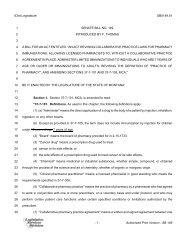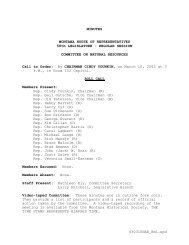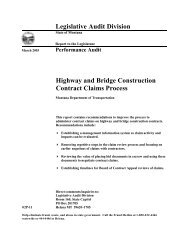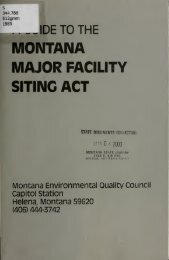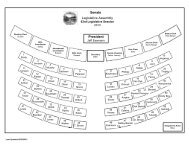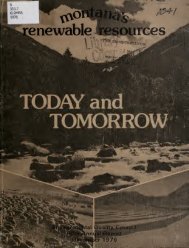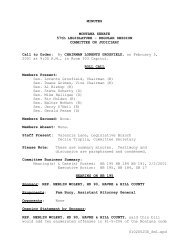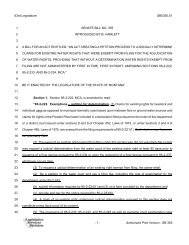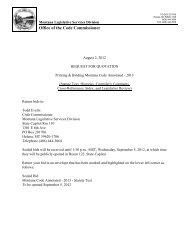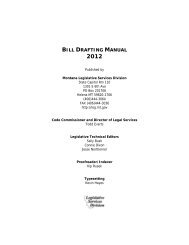Public Comment. Volume III - Montana Legislature
Public Comment. Volume III - Montana Legislature
Public Comment. Volume III - Montana Legislature
Create successful ePaper yourself
Turn your PDF publications into a flip-book with our unique Google optimized e-Paper software.
DRAFT, 4/9/85<br />
(a) quality<br />
(b) forming feature<br />
riffle (ft.)<br />
run (ft.)<br />
substrate<br />
(a boulder (greater than 12 inches 1<br />
(b) cobble (12-2.5 inches 1<br />
(C 1 coarse gravel (2.4-. 5 inches 1<br />
(d) fine gravel (.4-.1 inches)<br />
(el sand<br />
(f clay<br />
stream bank soil alteration rating<br />
stream vegetative stability rating<br />
stream bank undercut and angle<br />
vegetation overhang<br />
embeddedness<br />
Benthic Macroinvertebrates . Quantitative samples<br />
of benthic macroinvertebrates should be collected<br />
immediately upstream and downstream of each proposed<br />
location of disturbance. The collected specimens<br />
should then be counted and identified at<br />
least to genus and to species where possible. The<br />
composition.of the community should be described.<br />
c. Fish Spawning Survey. Several species of game fish<br />
spawn in the Tongue River , including . sauger,<br />
walleye, channel catfish, smallmouth bass, and<br />
sturgeon. A game fish spawning potential survey<br />
should be conducted at each proposed bridge location<br />
as well as areas of proposed extensive<br />
riprapping. Sampling periods for the spawning survey<br />
would be early spring after ice breakup, after<br />
peak runoff, and in the fall. Collection methods<br />
would include electro-shock, seining, trap netting,<br />
and fry sampling.<br />
Mitigation ~echniques. Once sampling has been completed<br />
and detailed data on the aquatic resource to be<br />
affected have been obtained, mitigative measures can be<br />
delineated. Some of the measures that could become<br />
necessary include:<br />
a. Preparation of a construction schedule which provides<br />
for instream work at those times least critical<br />
to the specific fishery or aquatic resource<br />
occurring at a site, as well as the period least<br />
conducive to sediment transport. Such periods<br />
differ by stream and species affected.<br />
-208- <strong>Volume</strong> Ill: <strong>Public</strong> <strong>Comment</strong>



